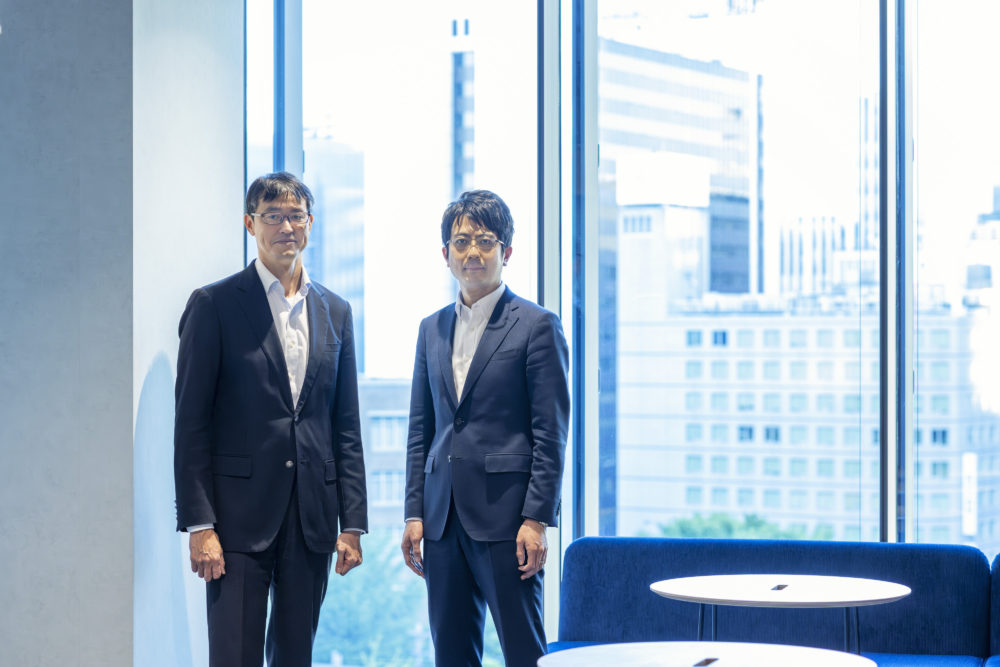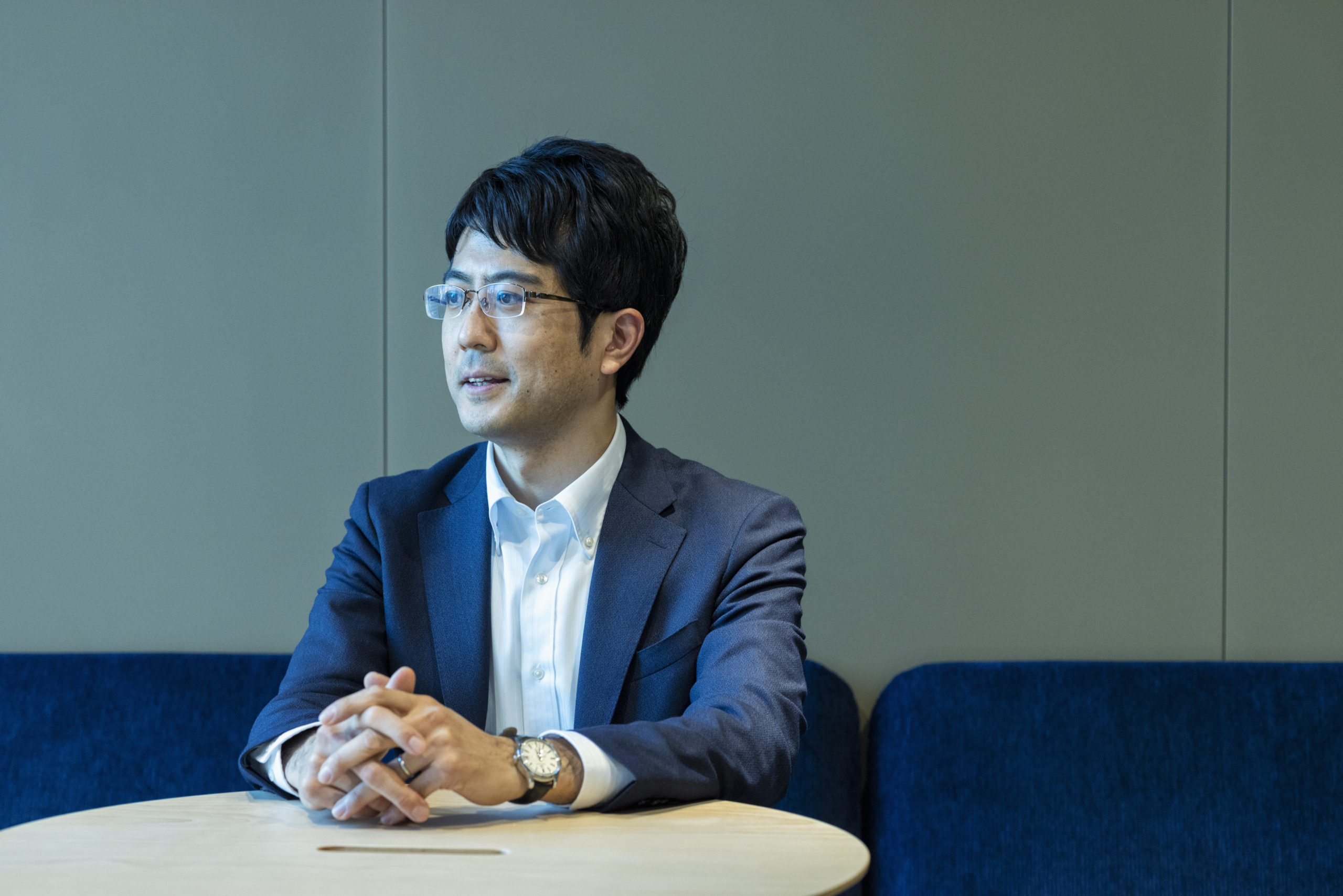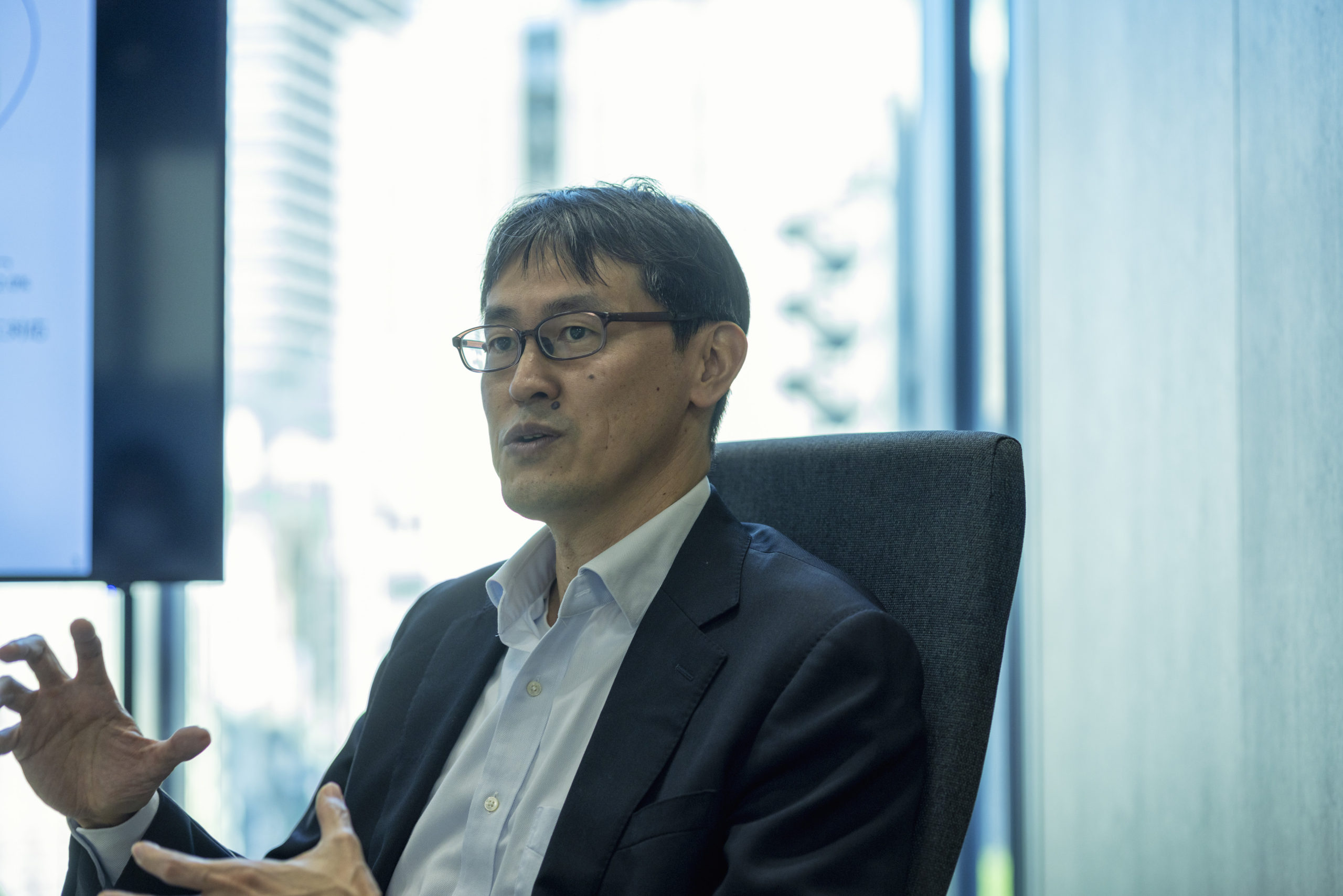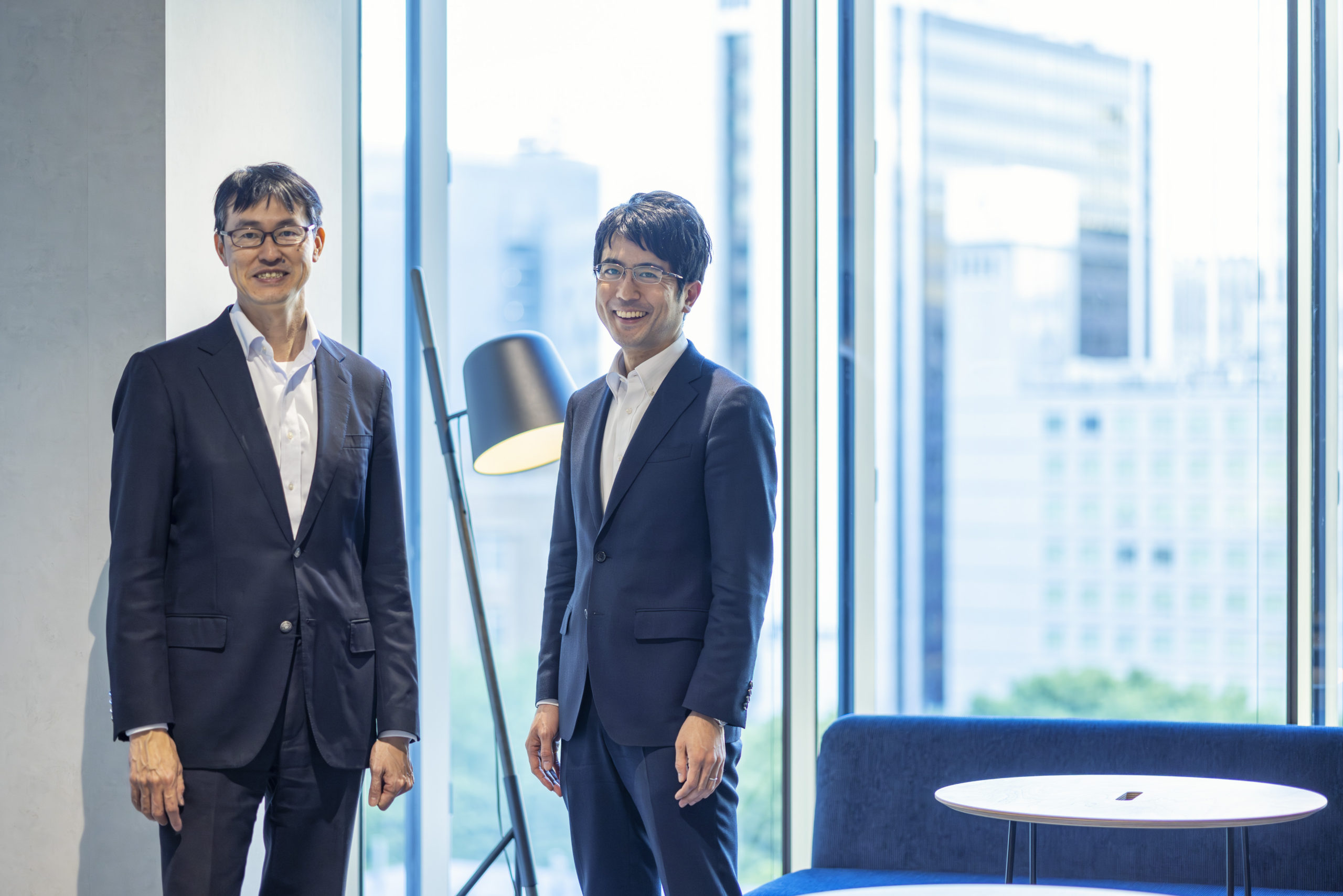
Unshackling Innovation: Pioneering a New Era in R&D with Virtuous Cycle
Research and development (R&D) are crucial for the long-term growth and success of any company. To gain insights into the current challenges and strategies of Japanese companies in the field of R&D, we interviewed two professionals, Mr. Kazuya Suzuki and Mr. Masaaki Tashiro, who have a wealth of experience in managing numerous R&D projects at Dream Incubator Inc. (DI).
Executive Officer
Mr. Kazuya Suzuki (on the left side of the picture)
He is a graduate of Keio University’s Faculty of Policy Management. He also holds an MBA from Northwestern University’s Kellogg School of Management. Before joining DI, he gained valuable experience working at renowned companies such as Sony Corporation and Booz & Company. In his role at DI, Mr. Suzuki is responsible for devising and executing corporate growth strategies. This includes spearheading new business development, expanding overseas markets, providing M&A and partnership support, as well as shaping R&D strategies across various industries. These industries encompass electronics, automobiles, consumer goods, environmental energy, healthcare, chemicals, and finance.
Executive Officer
Mr. Masaaki Tashiro (on the right side of the picture)
He holds a degree from the Department of Social Engineering, Faculty of Engineering at the Tokyo Institute of Technology. After completing his graduate studies in the Department of Social Engineering at the Graduate School of Decision Science and Technology, he joined DI as a new graduate. With over 15 years of experience at DI, Mr. Tashiro has dedicated his efforts to commercializing R&D themes, developing new businesses, and establishing mechanisms in various industries, with a special focus on the manufacturing industry.
Unraveling the Endless Loop: Japan’s Unfortunate R&D Cycle

What are some of the challenges that organizations consulting with DI on R&D confront?
Mr. Tashiro:
The expansion of R&D domains is giving rise to several challenges. Take, for example, R&D for automotive OEMs. Traditionally, this sector primarily focused on mechanical aspects. However, in recent years, the scope of R&D has broadened to encompass software and artificial intelligence (AI). While this expansion presents exciting opportunities, it also poses a dilemma. It is simply not feasible for a single entity to cover such a wide range of diverse R&D themes. Consequently, allocating R&D resources has become increasingly complex.
Mr. Suzuki:
Many Japanese companies appear to be grappling with a significant sense of stagnation in their R&D efforts. Over the course of more than a decade, we have been inundated with inquiries lamenting the failure of R&D to yield true innovation. However, the landscape seems to have shifted in recent years, as an increasing number of queries now revolve around the optimum allocation of R&D resources at the corporate level and identifying research themes that could pave the way for substantial future growth in business.
What do you think of R&D in Japan in comparison to overseas companies?
Mr. Tashiro:
From a macro perspective, Japan’s R&D-to-GDP ratio has remained high in comparison to other countries. However, Japan’s GDP growth has been modest; GDP in the United States and China, on the other hand, is increasing. R&D and GDP are not inextricably linked, but one way to look at it is that R&D in Japan does not appear to be linked to GDP growth.
Japan has made massive R&D investments.

Mr. Suzuki:
When we analyze individual companies, it becomes evident that U.S. enterprises exhibit a higher degree of assertiveness when it comes to R&D investment compared to Japanese counterparts. Prominent tech giants like GAFAM, NVIDIA, and Broadcom are all intensifying their R&D investments as a proportion of their overall sales. This dynamic sets in motion a virtuous cycle wherein companies actively engage in R&D, subsequently observing a boost in sales and profits. These financial gains are then reinvested back into R&D, ultimately bolstering the overall value of these companies.
U.S. companies are taking an aggressive approach to R&D investment

Mr. Tashiro:
In the U.S., there seems to be a noticeable shift in the focus of R&D from the confines of the laboratory to practical applications. This evolving trend can be observed through the increasing efforts of tech giants like Amazon and Google, who are not only delivering innovative services to their customers but also actively engaging in problem-solving endeavors that arise as a result of their expanded R&D investments. In contrast, longstanding companies such as IBM, GM, and Ford are encountering a deceleration in their R&D expenses, reflecting a potentially worrisome pattern of sluggish growth. This changing landscape indicates a shifting epicenter of innovation, rerouting the central hub of groundbreaking ideas and technologies.
Mr. Suzuki:
On the other hand, despite significant R&D investments, Japanese corporations have difficulty trying to stimulate innovation. As a result of this struggle, sales are slowing, and profit growth is constrained. As a result, questions such as “What is the point of all this?” and “Are we spending too much money?” begin to emerge, gradually leading to a diminishing equilibrium. According to our assessment, this negative spiral, commonly referred to as a “vicious cycle,” has contributed to the prevalent sense of stagnation. I’ve read that many doctoral graduates from Japanese science universities are increasingly choosing to work for foreign corporations or abroad, which I believe is also a sign of stagnation.
R&D investment in the U.S. is a virtuous cycle, whereas it is a vicious cycle in Japan.

The Vicious Cycle of R&D: Unveiling the Three Crucial Factors

Why has Japan encountered a vicious cycle like the one mentioned above?
Mr. Tashiro:
One of the challenges in today’s business landscape is the complexity of issue clarification. In the past, companies could focus on improving product performance, which directly transformed into increased sales. However, with the evolution of market dynamics and the diversification of customer values, it has become increasingly difficult to pinpoint and define the key issues without a thorough understanding of the sector. A classic example is Amazon’s AWS, which developed in response to the pressing challenge faced by the technology industry: the need to efficiently handle the immense number of user accesses worldwide. In contrast, Japan, with its primarily manufacturing-focused industry and lack of field expertise, is dealing with intangible issues that are not easily identified or addressed.
Mr. Suzuki:
Another issue is the unrestricted expansion of R&D themes. If left unmanaged, various organizations’ R&D departments would continue to develop inexorably, prompting the abandonment of projects that do not make major contributions to the organization. Nonetheless, R&D necessitates highly specialized knowledge, even if one theme were to be discontinued, it would not be easy to retrain the workforce, making it difficult to metabolize new R&D themes.
Mr. Tashiro:
One more arising concern is the limited liquidity of R&D. The notion of “Not Invented Here (NIH)” is widely used, with Japanese manufacturers preferring to rely on their knowledge and maintain R&D activities in-house. While there is an increasing trend towards open innovation, it is upsetting to see valuable technology developments go undetected and unutilized within an organization.
How do you think we can break Japan’s vicious circle?
Mr. Tashiro:
I think that researchers should be more actively involved in fieldwork. It’s crucial to establish a system where researchers can identify real-life challenges faced in the field and incorporate them into R&D processes. Take Panasonic, for instance. They engage in convenience store franchising and utilize the issues they encounter in the field to inform their R&D efforts. Similarly, Komatsu has acquired a construction equipment leasing company and is actively developing new solutions based on the needs of customers on-site. In the past, it has been important to utilize distributors to efficiently sell a large number of products, but I believe that in the coming years, it will become imperative for manufacturers to establish platforms where their products can be showcased and utilized.
Mr. Suzuki:
From an accountability perspective, both corporate performance and fund management are closely examined by investors. In instances where a higher level of accountability is required, the allocation of resources and management of portfolios is meticulously handled taking into consideration both risk and return. There has also been considerable concern regarding the need for stronger portfolio management of R&D themes.
Mr. Tashiro:
I also believe it is critical to have a method for monetizing R&D that extends beyond the company’s boundaries. These ideas are exemplified by NEC and Fujitsu’s recent projects, dotData, and QD Laser, respectively. These new endeavors arose from their commitment to maximizing the value of R&D initiatives. It is vital to develop a solid link between R&D achievements and financial returns by adopting a broader strategy rather than limiting it to the organization.
Innovation ignites on the frontline: Groundbreaking R&D initiatives spark a productive cycle

You mentioned earlier that researchers must go to the field. What kind of support does DI provide?
Mr. Tashiro:
It is critical to recognize that the R&D landscape has changed dramatically in recent years. We must abandon the outdated belief that developing amazing technology automatically ensures its successful commercialization. Frequently, we come across requests such as, “We are involved in a wide range of R&D endeavors, so please devise something that can be transformed into a viable commercial product.” Pursuing solutions that do not meet customer issues or match market demands is pointless. As a result, we have progressively embraced a more proactive approach in which we collaborate directly with our customers, accompanying our researchers to the field and studying the development and commercialization of R&D themes from the market and client perspectives.
Mr. Suzuki:
For over fifty years, experts have been emphasizing the importance of adopting a customer-centered approach rather than a product-centered one. The classic tale tells us that customers seeking to purchase a drill are not interested in the drill itself, but rather in the result it brings – a hole. This fundamental shift in mindset is crucial not only in the realm of R&D but also in reimagining our entire business structure. We must ask ourselves, “What type of establishment are we?” This question serves as a vital focal point as we navigate the ever-evolving business landscape and strive to meet the needs and desires of our customers.
Mr. Tashiro:
For example, Amazon is involved in a variety of projects, ranging from the creation of e-book devices such as the Kindle to the development of hardware like warehouse robots and unmanned storefronts. While the company is classified as being in the retail industry, it also manufactures and provides IT services. This begs the question as to whether the problem lies in the rigid separation of industries. From a customer’s perspective, we are compelled to conduct in-depth R&D, starting from on-site issues. Amazon’s scope of operations extends beyond conventional retail practices, encompassing diverse sectors and requiring continuous innovation to meet customer demands.
Mr. Suzuki:
For that purpose, it is critical to familiarize researchers with the domain. We expose them to the market, allowing them to get vital insights into the field’s difficulties and worries. We can stimulate innovation and drive the establishment of new companies by listening to the actual voices of consumers and understanding their requirements. Furthermore, we must concentrate on the systemization of these breakthroughs. I am convinced that the process must be redefined to meet the demands of the modern day. Only by evolving and adapting to changing conditions can we ensure that our efforts continue to operate long after we are gone.
Mr. Tashiro:
An illustration of such support for new businesses derived from field-based R&D can be observed in the Tokyo Metropolitan Expressway initiative. The Tokyo Metropolitan Expressway, known for its significant traffic volume, presents challenges when it comes to closing it off to traffic. Consequently, the Tokyo Metropolitan Expressway has taken on the responsibility of conducting R&D to effectively evaluate and maintain road conditions. DI has extended its support to this project due to the remarkable technological advancements achieved through practical experience as well as the project’s potential for broader business expansion. It is my belief the commercialization of this form of field-based R&D will continue to rise in the future.
Creating a robust R&D framework from scratch

What other assistance does DI provide?
Mr. Suzuki:
One of the most commonly asked concerns we receive about R&D management is about the distribution of R&D resources at the corporate level. For example, if the head office uses 10 billion yen of a 100-billion-yen company-wide R&D budget, how should these 10 billion yen be distributed? We assist in striking a healthy balance between themes that foster innovation and facilitate the creation of new businesses, and fundamental themes that have the potential to benefit multiple existing businesses. It is crucial to address this matter, as unmonitored R&D activities at the headquarters may exhibit a bias towards themes that favor existing businesses.
Click here to see examples of R&D support (Japanese only) Link
Mr. Tashiro:
Along with individual company activities, it is critical to develop support that extends beyond corporate boundaries. Corporate Venture Capital (CVC), a component of open innovation, is becoming more common, but its efficacy is not always clear. As a result, we are also supporting the development of a framework for implementing open innovation as a corporate strategy. The liquidity of R&D is also an important factor to consider. Rather than confining R&D to a single company, building an environment where technology interchange between the businesses and R&D sectors may occur openly and freely across company borders is likely to increase R&D investment efficiency tremendously.
Mr. Suzuki:
The consideration of relaunching the company’s R&D operations can provide useful insights into its future course of action. Over time, the external landscape has seen major changes. The need to rely solely on the company’s products may no longer be necessary, as significant advances in technology have lowered transaction costs with third parties. Furthermore, the division of labor between R&D and sales, as well as within R&D, may have made it impossible to link customer value to technological development. As with resource allocation, it is critical to shift the company’s focus away from past methods and onto what lies ahead. By taking this proactive strategy, we can better identify the path to success and gain a competitive advantage in the market.
Mr. Tashiro:
The founding of the “TOYOTA RESEARCH INSTITUTE, INC.” especially for Toyota Motor Corporation was an example of DI’s support. At the time, AI and robotics research were on the verge of technical breakthroughs. Given the complexities of the subject area, it became clear that the existing R&D organization and structure were inadequate for the task at hand. As a result of this realization, it became imperative to completely reassess our approach, leading to the establishment of a separate research institution functioning as an autonomous enterprise based in the United States.
“We want to create a new virtuous cycle model of R&D that takes advantage of Japan’s strengths.”
Could you please share any final thoughts or messages you’d like to leave with us?
Mr. Suzuki:
I am confident in Japan’s potential to thrive at providing excellent customer service and quickly resolving issues. We are proud of the high quality of our service business, which includes rapid home delivery and well-run railway operations. The obvious contrast between 7-Eleven stores in Japan and the U.S. is a classic example of this. I am confident that if we can combine these assets with Japan’s great technological capabilities, we will be able to compete and succeed on a global basis. It is my honest wish to be a part of the process of modernizing our R&D system to better meet the needs of the modern day.
Mr. Tashiro:
R&D challenges might be classified as social concerns. To maintain its status as a technology-driven country, Japan must confront the current situation. If the current state persists, in which R&D outputs fail to provide economic value, the circle of adversity will continue unbroken, leading to the depletion of human resources and the stagnation of R&D. We are completely committed to resolving this situation as soon as possible. With this goal in mind, DI seeks to engage closely with our clients, aiming to develop a virtuous cycle of R&D.

